Experimental tank Holt Gas-Electric Tank (USA)
The emergence of the Holt Gas-Electric Tank project was preceded by a fairly long and complex program of research and testing of various prototypes. For several years, a number of leading US industry organizations have been working on various issues and the construction of experimental equipment. A significant contribution to the development of US armored vehicles was made by Holt Manufacturing Company. This company was engaged in the construction of agricultural and construction equipment, including tracked vehicles. Existing experience in developing such machines was most actively used to create new types of armored vehicles.
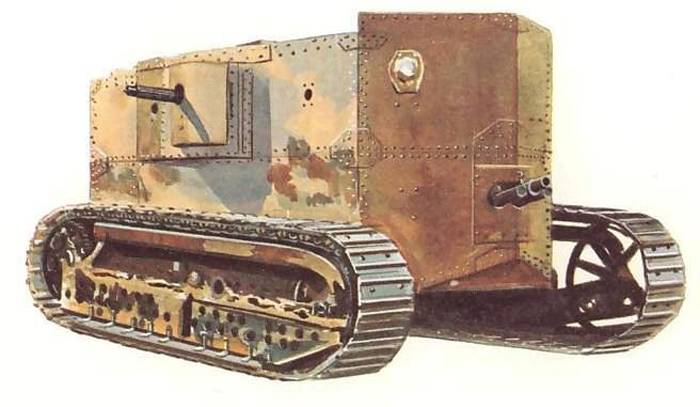
Modern reconstruction of the image of the tank Holt Gas-Electric Tank
Initially, the experimental Holt armored vehicles were built in the simplest possible way. The ready-made tracked chassis, developed for a serial or experienced tractor, was equipped with an original armored body and means for mounting weapons. Such improvised armored vehicles showed insufficient characteristics, and thus demonstrated the feasibility of developing a special chassis. At the beginning of 1917, it was decided to create a completely new tank on a specially designed chassis. The use of ready-made units and existing experience was not excluded, but they should only complement new ideas and solutions.
In the framework of the new project, Holt Company designers proposed to use a power unit with a so-called. electric transmission. Due to the limited capacity in this area, Holt was forced to seek help from General Electric. The development of a new project was carried out in the framework of cooperation between the two companies. Nevertheless, despite the significant contribution of General Electric, only the name Holt Company appeared in the common name of the finished tank.
The use of an internal combustion engine together with an electric transmission led to the appearance of a corresponding project name. The experimental armored vehicle remained in history under the name Holt Gas-Electric Tank - “Gasoline-electric tank“ Holt ”. Other designations or names are unknown.
It was planned to create a promising armored vehicle using some ready-made parts. The main source of the aggregates was to become the Holt Model 75 serial commercial tracked tractor. At the same time, the tank chassis, based on the existing units, should have been characterized by increased dimensions and a reinforced design. There should also have been noticeable changes associated with the applied electric transmission.
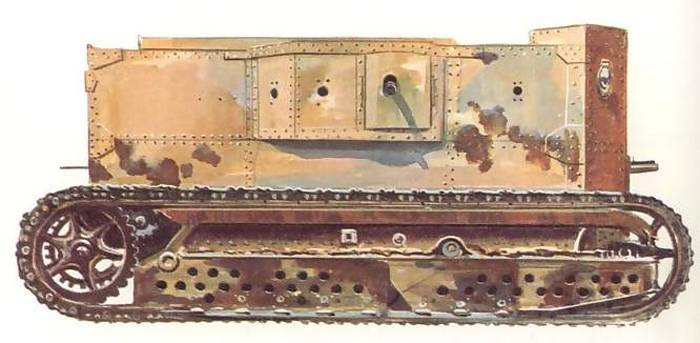
Starboard view
Especially for Gas-Electric Tank, a new armored hull was developed. It was proposed to make it from rolled sheets with thickness from 6 to 15 mm. The most powerful booking was to cover the frontal and side projections. Sheets of armor were proposed to be mounted on a frame made of profiles and fastened using rivets. The front and center of the corps served as a habitable combat compartment. In the stern, at the left side, located the engine compartment. To his right, a corridor was provided for access to the habitable compartment.
The frontal part of the promising tank was wedge-shaped in plan and assembled from four parts. The upper part of the frontal aggregate was slightly increased in height and formed a kind of cutting. From below, an inclined triangular sheet was attached to the frontal parts. The hull received vertical sides, together with a horizontal roof and a bottom, forming a rectangular structure. In the center of the sides sponsons were provided. Their front part had a large opening for armory installation. The central element of the sponson was located parallel to the board, the rear - at an angle to it. Instead of a single feed sheet, the hull had several separate parts. On the left, the feed was covered by a movable grill, which performed the functions of protecting the radiator. To her right was the door.
Chassis perspective tank received its own protection. As a basis for it, oblong details of complex shape were used, which served as supports and armor plates. Thus, the upper part of such a unit had a chute to support the tracks, and the lower part covered the track rollers. The front part of the armor part covered the rear half of the guide wheel, while the stern lead had no protection.
In the aft compartment of the hull there was a four-cylinder Holt gasoline engine that developed power up to 90 hp. This engine was connected to an electric generator developed by General Electric through a simple transmission. The electric power from the generator went to the control devices, after which it went to a pair of traction motors. The latter were located at the sides of the hull, at the level of its bottom. Torque was given to the drive wheels with chain transmissions.
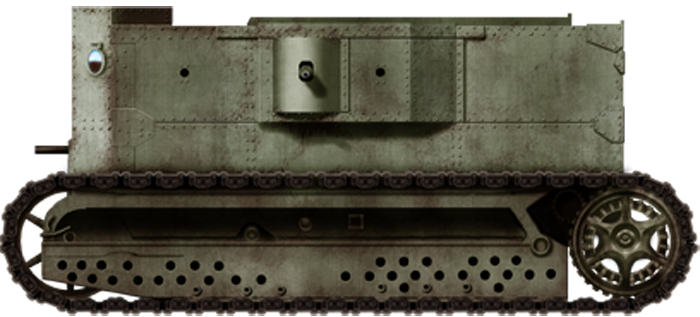
Left view
Due to the imperfection of technology, the gasoline engine and electric motors emitted excessive heat and could easily overheat. To compensate for this drawback, the tank was equipped with an advanced liquid cooling system. Excess heat was to be transferred to atmospheric air using a large fodder radiator. In case of insufficient cooling of the radiator, the feeding grid was made movable: to improve cooling, it could rise to a certain angle.
The design of the undercarriage was created with extensive use of parts of the Model 75 tractor. Two parts of the tracked propulsion unit were mounted on the sides of the hull, outside of its projection. The chassis consisted of ten small road wheels on each side. The rollers were mounted on a suspension with vertical springs. In front of the chassis were large steering wheels, in the stern - leading. The guides and drive wheels were lowered onto the ground and increased the surface area. Chassis Holt Gas-Electric Tank did not have supporting rollers. The upper branch of the caterpillar was supposed to move along a rail formed by the upper part of the chassis beam.
The main weapon of the new tank was supposed to be the 75-mm rifled mountain gun Vickers British design. Its installation was at the junction of the two lower frontal sheets and allowed to fire within a sector of small width with limited elevation angles. Ammunition consisting of several dozen unitary shells of various types was to be stored in the stacks of the front of the fighting compartment.
The main artillery gun was complemented by a pair of Browning M1917 machine gun rifles. The main location of the machine gun was a movable mask in front of the sponson. At the same time, there were additional embrasures on the sides and in the stern of such protruding aggregates, which could be used together with machine guns. Ammunition of two machine guns could consist of several thousand cartridges in canvas ribbons. Boxes with ribbons proposed to be transported on the racks of the fighting compartment.
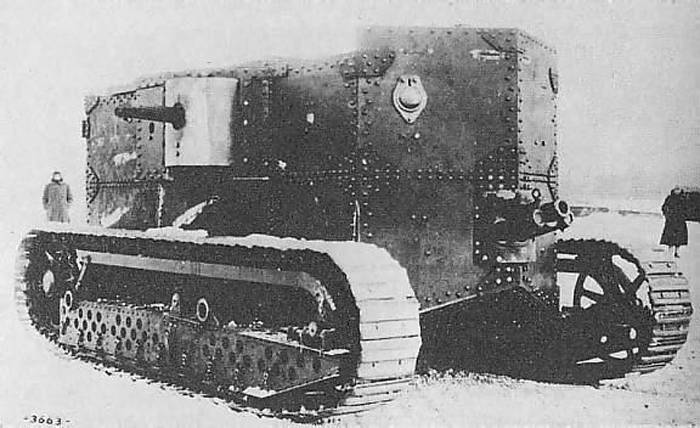
Experienced Holt Gas-Electric Tank on trial
The crew of the promising "Gasoline-electric tank" was to consist of six people. According to reports, the driver and the commander were located in front of the car. Their jobs were raised above the main combat compartment, and it was for them that a small cabin was formed, formed by the upper part of the forehead of the corps. In connection with the use of electric transmission, the driver’s control room had instruments for controlling the operation of the engine, as well as electrical devices. It was proposed to control the total power of the power plant by changing the operating parameters of the gasoline engine. A separate electrical panel regulated the flow of current to the traction motors. By changing the power of electric motors, the driver could perform the necessary maneuvers.
Below the commander and the driver had to work two gunners: loader and gunner. The operation of two machine guns was assigned to two shooters. In the frontal and side parts of the armored corps provided a significant number of inspection slots and hatches. Some of them could also serve as embrasures for small arms.
Like some other armored vehicles of its time, Holt Gas-Electric Tank had only one door for access inside. Tankmen were asked to fall into place through the opening in the right side of the stern, passing by the engine compartment. No other hatches in the sides or the roof were used.
Perspective armored car turned out quite compact. Its total length slightly exceeded 5 m. Width - 2,76 m, height - less than 2,4 m. Enough thick booking and non-standard composition of the power plant led to an increase in combat weight to 25,4 tons. per ton did not allow to count on high mobility characteristics. The maximum speed on a good road did not exceed 3,5 km / h, the cruising range was 10-45 km.
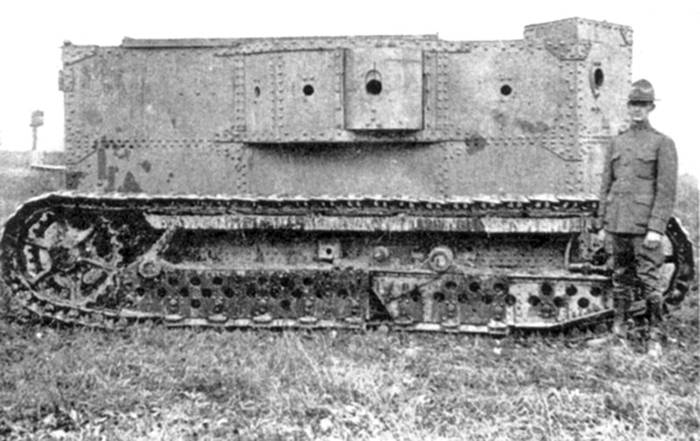
Tank on the ground
The development of the Holt Gas-Electric Tank project continued until the end of 1917, and ended with obtaining a building permit for the first prototype. By the middle of the next 1918, Holt built a prototype tank and equipped it with a power plant with electrical units from General Electric. As far as is known, the tank went into the first tests without a full armament complex. According to various sources, at this moment there were at least no machine guns on it.
Tests prospective armored vehicles with a gasoline-electric power plant did not take much time. In just a few weeks, it was possible to determine the main pros and cons of the design, as well as to draw conclusions about its suitability for practical operation. It is noteworthy that, having barely entered the landfill, the Holt Gas-Electric Tank armored vehicle automatically received the honorary title of the first full-fledged tank, developed from scratch, built and launched for testing by the United States. Such a title would remain with her, regardless of the results of subsequent inspections.
It was quickly established that the original tank had an unacceptably low mobility. Even with the connection of the 90-strong gasoline engine with drive wheels through the mechanical transmission could not count on high performance. The presence of a fairly complex electric transmission, which did not differ in high efficiency, further aggravated the situation. In addition, electric transmission was not reliable enough and regularly broke.
A separate problem was the constant overheating of the power plant. The gasoline engine, the generator and the electric motors, together with the means for cooling them, were located in the closed volume of the hull with insufficient influx of outboard air. The removal of released heat could not be significantly improved even at the expense of a raised feed grate. It should be noted that in a combat situation a trip with an open stern could be completed in the saddest way.
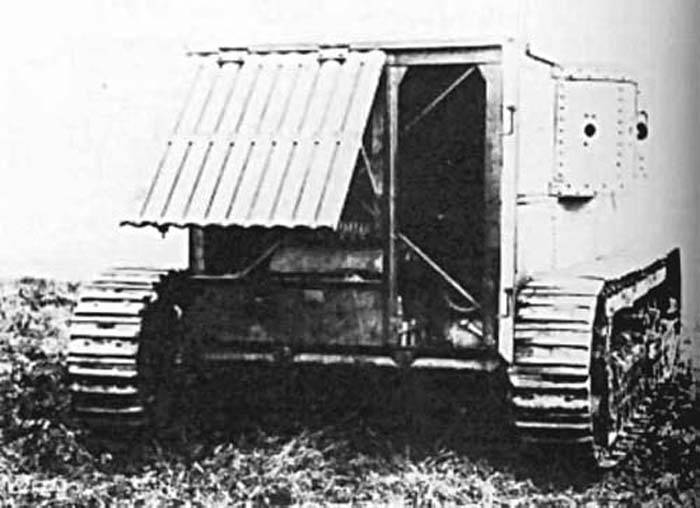
Armored feed. Engine hatch and door open to improve ventilation
Because of an imperfect power plant, an experienced tank, even on a good road, could not reach a speed of more than 9-10 km / h. On rough terrain, the speed dropped noticeably. On the slopes or walls of the car climbed with great difficulty. However, some of these obstacles proved to be insurmountable.
Used weapons complex, in general, was not bad. A single 75-mm frontal cannon and a pair of machine guns in the onboard sponsons made it possible to attack targets in various directions, subjecting the front hemisphere objects to the most intense shelling. However, the used placement of weapons imposed certain restrictions on its use in combat situations. However, other armored vehicles of that time had similar weapons, and in this respect the “Gasoline-electric tank” did not stand out much against their background.
The layout of the fighting compartment was not very convenient. The main tool and the workplace of its calculation were at a small height above the bottom of the hull, and some sort of control unit was located directly above them. It is unlikely that such a layout of the habitable compartment could be convenient for the crew. Only the jobs of the side shooters differed in tolerable ergonomics, but when traveling over rough terrain, they had to endure the inconvenience.
In its current form, the first American tank Holt Gas-Electric Tank had a lot of problems of various kinds, which in one way or another impeded its operation and combat use. There were virtually no real advantages over existing armored vehicles. The only advantage of the project was the fact of its existence. Thanks to this, the United States was able to enter a narrow circle of countries capable of independently developing and building tanks. The serial production and use of new machines in the army, for objective reasons, was excluded.
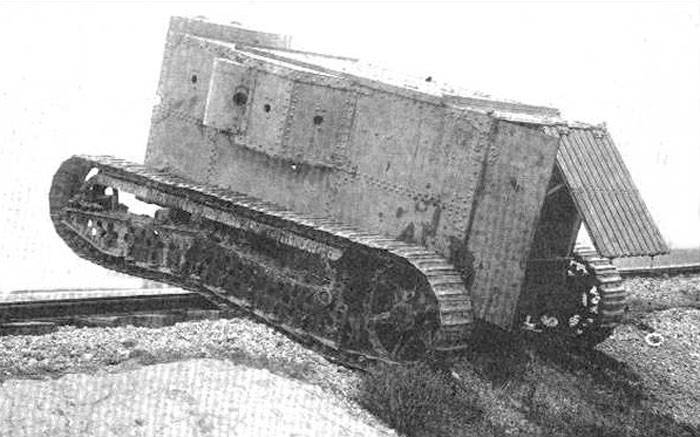
Holt Gas-Electric Tank climbs the obstacle
The tests of the only built “Gasoline-electric tank” were carried out in the middle of 1918 and ended with negative conclusions. The first tank of the United States was unsuccessful and was not of interest to the army. In addition, the prospects of this machine seriously hit the new international treaties. By this time, the US military had managed to order and receive imported FT-17 and Mark V tanks of French and British production, respectively. This technique was not without flaws, but against the background of its own Gas-Electric Tank looked the best way.
The first US tank remained in a single copy. The assembly of the second prototype was not planned. After completion of the tests, the first and last Holt Gas-Electric Tank remained in storage for some time, and then went for recycling. Unfortunately, lovers of early armored vehicles, now a unique car can be seen only in the few surviving photos from the tests.
In the middle of the tenth years of the 20th century, not a single country in the world could boast of great experience in creating the latest tank-class armored vehicles. Such machines were created by trial and error with regular testing of new ideas with the help of prototypes of a particular appearance. In fact, the Holt Gas-Electric Tank became the next prototype, designed to practice the original technical solutions. He was able to reach the tests, showed the main problems of his design, and also allowed to determine the future development of armored vehicles. In addition, the "Holt" gasoline-electric tank left behind the honorary title of the first American car of its class. However, numerous shortcomings did not allow him to become the first US serial tank.
On the materials of the sites:
https://militaryfactory.com/
http://tanks-encyclopedia.com/
https://aviarmor.net/
http://landships.info/
http://alternathistory.com/
- Ryabov Kirill
- Alternathistory.com, Tanks-encyclopedia.com
Information